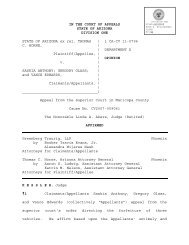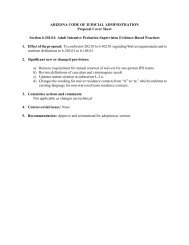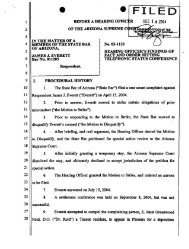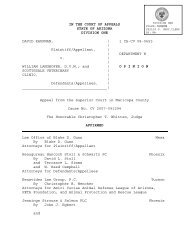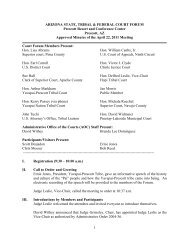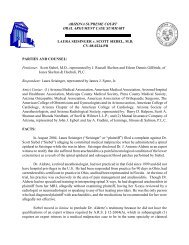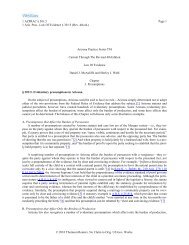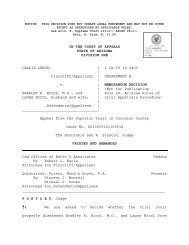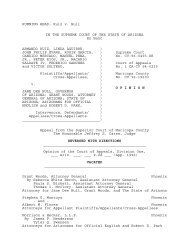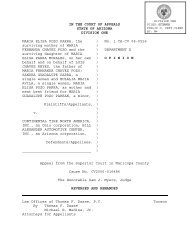State v. Kendrick - Arizona Judicial Department
State v. Kendrick - Arizona Judicial Department
State v. Kendrick - Arizona Judicial Department
You also want an ePaper? Increase the reach of your titles
YUMPU automatically turns print PDFs into web optimized ePapers that Google loves.
IN THE COURT OF APPEALS<br />
STATE OF ARIZONA<br />
DIVISION ONE<br />
STATE OF ARIZONA, ) No. 1 CA-CR 11-0849<br />
) 1 CA-CR 11-0850<br />
Appellee, ) (Consolidated)<br />
)<br />
v. ) DEPARTMENT B<br />
)<br />
JUSTIN SCOTT KENDRICK, )<br />
) O P I N I O N<br />
Appellant. )<br />
__________________________________)<br />
Appeal from the Superior Court in Maricopa County<br />
Cause Nos. CR2010-145260-001 & CR2007-006213-001<br />
The Honorable Joseph C. Kreamer, Judge<br />
REVERSED AND REMANDED WITH INSTRUCTIONS<br />
Thomas C. Horne, <strong>Arizona</strong> Attorney General<br />
Phoenix<br />
By Joseph T. Maziarz, Chief Counsel Criminal Appeals<br />
and Liza-Jane Capatos, Assistant Attorney General<br />
Attorneys for Appellee<br />
James J. Haas, Maricopa County Public Defender<br />
By Charles R. Krull, Deputy Public Defender<br />
Attorneys for Appellant<br />
Phoenix<br />
N O R R I S, Judge<br />
1 The issue in this appeal is whether a probationer’s<br />
unauthorized removal of an electronic monitoring device,<br />
required as a condition of probation, constitutes escape in<br />
violation of <strong>Arizona</strong> Revised Statute (“A.R.S.”) section 13-
2503(A)(2) (Supp. 2012). 1<br />
We hold it does not. Accordingly, we<br />
reverse Justin Scott <strong>Kendrick</strong>’s conviction for escape, vacate<br />
the superior court’s finding that he violated his probation, and<br />
remand for further proceedings consistent with this opinion.<br />
FACTS AND PROCEDURAL BACKGROUND<br />
2 In 2008, <strong>Kendrick</strong> pled guilty in Maricopa County<br />
Superior Court Cause No. CR2007-006213-001 to attempted<br />
molestation of a child and sexual abuse, both class three<br />
felonies and dangerous crimes against children (“2007 case”).<br />
Pursuant to his plea agreement, the superior court suspended<br />
imposition of sentence on each count and placed <strong>Kendrick</strong> on<br />
lifetime probation. As a condition of probation and as required<br />
by A.R.S. § 13-902(G) (Supp. 2012), the superior court subjected<br />
<strong>Kendrick</strong> to global positioning system (“GPS”) monitoring for the<br />
term of his probation (“monitoring order”). 2<br />
1 Although the <strong>Arizona</strong> Legislature amended certain<br />
statutes cited in this opinion after the date of <strong>Kendrick</strong>’s<br />
offense, the revisions are immaterial. Thus, we cite to the<br />
current version of these statutes unless otherwise noted.<br />
2 Section 13-902(G) mandates GPS or electronic<br />
monitoring of registered sex offenders placed on probation for<br />
certain dangerous crimes against children.<br />
2
3 In July 2010, a probation officer petitioned to revoke<br />
<strong>Kendrick</strong>’s probation, alleging he had violated his probation by,<br />
inter alia, interfering with the electronic monitoring device in<br />
violation of A.R.S. § 13-3725 (2010), absconding, and failing to<br />
comply with GPS monitoring as required by A.R.S. § 13-902(G).<br />
Subsequently, and as relevant here, in Maricopa County Superior<br />
Court Cause No. CR2010-145260-001, a grand jury indicted<br />
<strong>Kendrick</strong> for escape in the second degree, a class five felony<br />
(“2010 case”). A.R.S. § 13-2503(A)(2), (B). The petition to<br />
revoke <strong>Kendrick</strong>’s probation and escape charge arose out of his<br />
failure to wear a GPS monitoring device (“GPS unit”) on his<br />
ankle pursuant to the court’s monitoring order.<br />
4 A jury found <strong>Kendrick</strong> guilty of escape. The superior<br />
court sentenced <strong>Kendrick</strong> to a prison term for escape, and found<br />
he had violated his probation in the 2007 case based on his<br />
conviction in the 2010 case.<br />
The court reinstated <strong>Kendrick</strong> on<br />
lifetime probation to begin after his release from prison.<br />
DISCUSSION<br />
5 On appeal, <strong>Kendrick</strong> argues the superior court should<br />
have granted his motion for judgment of acquittal on the escape<br />
charge because the <strong>State</strong> failed to prove he had committed a<br />
“departure from custody . . . with knowledge that such departure<br />
[was] unpermitted” in violation of A.R.S. § 13-2501(4) (Supp.<br />
2012). Although <strong>Kendrick</strong> acknowledges he was required to wear<br />
3
the GPS unit as a condition of probation, he argues that<br />
requirement did not “constitute the constructive restraint<br />
sufficient to satisfy the definition of custody” in A.R.S. § 13-<br />
2501(3), the statute that defines “custody” for purposes of<br />
escape. Reviewing these arguments de novo, we agree. <strong>State</strong> v.<br />
West, 226 Ariz. 559, 562, 15, 250 P.3d 1188, 1191 (2011)<br />
(appellate court reviews ruling on motion for judgment of<br />
acquittal de novo); <strong>State</strong> v. Stauffer, 203 Ariz. 551, 554, 8,<br />
58 P.3d 33, 36 (App. 2002) (appellate court reviews issues of<br />
statutory construction and interpretation de novo).<br />
6 As charged in this case, a person commits escape in<br />
the second degree by knowingly “[e]scaping or attempting to<br />
escape from custody imposed as a result of having been arrested<br />
for, charged with or found guilty of a felony.” A.R.S. § 13-<br />
2503(A)(2).<br />
Under A.R.S. § 13-2501(4), and as relevant here,<br />
“‘[e]scape’ means departure from custody . . . with knowledge<br />
that such departure is unpermitted.” In turn, “‘[c]ustody’<br />
means the imposition of actual or constructive restraint<br />
pursuant to an on-site arrest or court order . . .”<br />
A.R.S.<br />
§ 13-2501(3).<br />
4
7 We have addressed the meaning of “custody” in two<br />
cases where, as here, the defendant removed an electronic<br />
monitoring device.<br />
But in each case, in addition to removing<br />
the device, the defendant also violated a court order that<br />
subjected the defendant to home detention. Thus, in <strong>State</strong> v.<br />
Williams, 186 Ariz. 622, 925 P.2d 1073 (App. 1996), we held the<br />
defendant had violated A.R.S. § 13-2503(A)(2) by removing an<br />
electronic monitoring device and departing from home detention<br />
without authorization. There, we explained: “Defendant’s<br />
removal of the electronic monitoring device and unauthorized<br />
departure from his home and <strong>Arizona</strong> constitute[d] an act of<br />
departing from court-ordered custody.”<br />
Id. at 623, 925 P.2d at<br />
1074. Similarly, in In re Brittany Y., 214 Ariz. 31, 32, 9,<br />
147 P.3d 1047, 1048 (App. 2006), we held a juvenile had violated<br />
A.R.S. § 13-2502(A) (2001) 3 by removing an electronic ankle<br />
monitor and leaving home after the juvenile court had imposed<br />
electronic monitoring and home detention as a condition of the<br />
juvenile’s release pending probation violation proceedings.<br />
8 Here, unlike Williams and Brittany Y., in the 2007<br />
case, the superior court did not order home detention, or<br />
confine <strong>Kendrick</strong> to any particular place, or require him to be<br />
3 Under this statute, a person commits escape in the<br />
third degree by knowingly escaping or attempting to escape from<br />
custody after being arrested for, charged with or found guilty<br />
of a misdemeanor or petty offense.<br />
5
at any place at a particular time.<br />
Although the terms of his<br />
probation prohibited him from going to certain places (for<br />
example, traveling outside Maricopa County or going to places<br />
primarily used by children, without permission from the<br />
probation department), 4<br />
<strong>Kendrick</strong>, who was living at a homeless<br />
shelter when arrested, could otherwise come and go as he pleased<br />
and live where he wished.<br />
9 The <strong>State</strong> argues, however, that the superior court’s<br />
monitoring order by itself constituted a court-ordered<br />
“constructive restraint” under A.R.S. § 13-2501(3). Noting the<br />
Legislature did not define “restraint,” the <strong>State</strong> relies on<br />
dictionary definitions and argues “restraint” should be<br />
construed broadly to include a range of meanings, from “[l]oss<br />
or curtailment of freedom” to “[a]n inhibiting influence.”<br />
Thus, the <strong>State</strong> argues the superior court’s order requiring<br />
<strong>Kendrick</strong> to wear the GPS unit as a condition of probation<br />
constituted a court-ordered “restraint” because it “inhibit[ed]<br />
him from violating the rules imposed as part of his probation<br />
and, at the same time, . . . curtail[ed] his freedom to move<br />
about without constant monitoring by the <strong>State</strong>.”<br />
4 The <strong>State</strong> has not argued that these probation terms<br />
subjected <strong>Kendrick</strong> to “custody” within the meaning of the escape<br />
statute.<br />
6
10 We reject the <strong>State</strong>’s argument that court-ordered<br />
electronic monitoring by itself constitutes restraint and thus,<br />
“custody” under A.R.S. § 13-2501(3).<br />
In construing a statute,<br />
our task is to “fulfill the intent of the legislature that wrote<br />
it.” <strong>State</strong> v. Williams, 175 Ariz. 98, 100, 854 P.2d 131, 133<br />
(1993) (citations omitted). In our view, the <strong>State</strong>’s definition<br />
of restraint goes beyond what the Legislature contemplated in<br />
enacting the escape statutes.<br />
A defendant placed on probation<br />
is subject to a host of restrictions and limitations on his or<br />
her freedom, all of which inhibit, and should inhibit, a<br />
probationer’s conduct. Prohibitions on alcohol consumption,<br />
drug testing requirements, and travel restrictions, to name a<br />
few, come to mind.<br />
Under the <strong>State</strong>’s expansive definition of<br />
restraint -- which could include any probationary term<br />
curtailing freedom or inhibiting conduct -- a probationer who<br />
violated these or other similar probation terms could be charged<br />
with escape.<br />
11 Although we may consider dictionary definitions in<br />
construing words in a statute in the absence of a specific<br />
statutory definition, we must consider their common meaning and<br />
ordinary usage in the context of the statutory scheme, and we<br />
are not obligated to apply all possible definitions.<br />
A.R.S.<br />
§ 1-213 (2002) (directing that words in statutes “be construed<br />
according to the common and approved use of the language”);<br />
7
<strong>State</strong> v. Wise, 137 Ariz. 468, 470 n.3, 671 P.2d 909, 911 n.3<br />
(1983) (“words and phrases in statutes shall be given their<br />
ordinary meaning unless it appears from context or otherwise<br />
that a different meaning is intended”); <strong>State</strong> v. Gray, 227 Ariz.<br />
424, 427, 9, 258 P.3d 242, 245 (App. 2011) (“We recognize that<br />
a dictionary definition may not be conclusive and, because<br />
‘context gives meaning,’ statutory terms should not be<br />
considered in isolation.”) (citation omitted).<br />
12 Further, we are not writing on a clean slate when it<br />
comes to the meaning of “restraint.” Our supreme court<br />
addressed the meaning of the term in the context of custody for<br />
resisting arrest and escape, and stated “the common<br />
understanding of the word connotes controlling, limiting, or<br />
restricting the movement of another.” <strong>State</strong> v. Stroud, 209<br />
Ariz. 410, 412, 9, 103 P.3d 912, 914 (2005). And, in Brittany<br />
Y., we relied on Stroud’s definition of restraint in concluding<br />
the juvenile there was “under restraint and in custody . . .<br />
because the juvenile court had restricted her movement by<br />
ordering home detention and electronic monitoring.”<br />
214 Ariz.<br />
at 32, 9, 147 P.3d at 1048. 5<br />
5<br />
Some states have defined escape to require a form of<br />
detention or confinement, while other states have adopted a more<br />
expansive definition of escape that would include removal of an<br />
electronic monitoring device by itself. Compare Commonwealth v.<br />
Wegley, 829 A.2d 1148, 1152 (Pa. 2003) (home detention and<br />
removal of electronic monitoring device constitutes escape),<br />
8
13 Here, the court-ordered GPS monitoring allowed the<br />
probation department to track <strong>Kendrick</strong>’s movements, but this<br />
monitoring did not confine or restrain his movements.<br />
As his<br />
probation officer testified at trial: “That is the intention of<br />
the GPS device, [it] is for monitoring the person’s whereabouts<br />
at given locations and exact times.” The GPS monitoring did not<br />
constitute “actual or constructive restraint” for purposes of<br />
“custody” under A.R.S. § 13-2501(3), and accordingly, <strong>Kendrick</strong>’s<br />
failure to wear the GPS unit did not constitute a “departure<br />
from custody” -- an essential element of escape -- in violation<br />
of A.R.S. § 13-2503(A)(2). Therefore, we vacate the judgment of<br />
guilt entered against <strong>Kendrick</strong> on the escape charge.<br />
Because<br />
the superior court found <strong>Kendrick</strong> had violated his probation<br />
based on the escape conviction, we also vacate the court’s<br />
finding that <strong>Kendrick</strong> had violated his probation in the 2007<br />
case, and remand that matter for further proceedings consistent<br />
with this opinion.<br />
CONCLUSION<br />
14 For the foregoing reasons, we vacate <strong>Kendrick</strong>’s<br />
conviction and sentence for escape in the second degree in the<br />
with Alaska Stat. § 11.56.310(a)(3) (West 2013) (escape includes<br />
removing, tampering with, or disabling electronic monitoring<br />
equipment), Ind. Code § 35-44.1-3-4(b) (West 2013) (escape<br />
includes violating home detention order or removing electronic<br />
monitoring device), and Minn. Stat. § 609.485 Subd. 2(7) (West<br />
2013) (escape includes absconding from electronic monitoring or<br />
removing electronic monitoring device).<br />
9
2010 case and the superior court’s finding he violated his<br />
probation in the 2007 case. On remand, the superior court shall<br />
enter a judgment of acquittal in the 2010 case, and in the 2007<br />
case conduct further proceedings consistent with this opinion.<br />
/s/<br />
PATRICIA K. NORRIS, Presiding Judge<br />
CONCURRING:<br />
/s/<br />
ANDREW W. GOULD, Judge<br />
/s/<br />
RANDALL M. HOWE, Judge<br />
10




